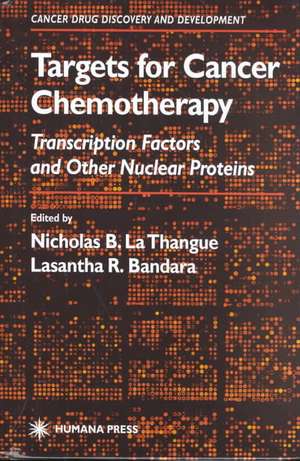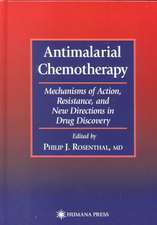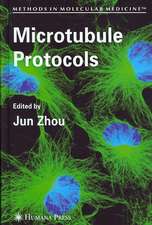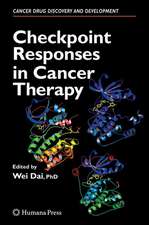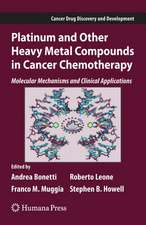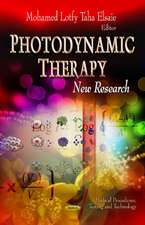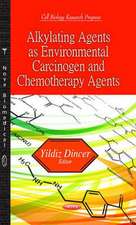Targets for Cancer Chemotherapy: Transcription Factors and Other Nuclear Proteins: Cancer Drug Discovery and Development
Editat de Nicholas B. La Thangue, Lasantha R. Bandaraen Limba Engleză Hardback – 3 apr 2002
| Toate formatele și edițiile | Preț | Express |
|---|---|---|
| Paperback (1) | 787.58 lei 6-8 săpt. | |
| Humana Press Inc. – 19 noi 2010 | 787.58 lei 6-8 săpt. | |
| Hardback (1) | 1105.95 lei 6-8 săpt. | |
| Humana Press Inc. – 3 apr 2002 | 1105.95 lei 6-8 săpt. |
Din seria Cancer Drug Discovery and Development
- 5%
 Preț: 1474.98 lei
Preț: 1474.98 lei - 5%
 Preț: 1108.35 lei
Preț: 1108.35 lei - 5%
 Preț: 1415.75 lei
Preț: 1415.75 lei - 5%
 Preț: 1370.22 lei
Preț: 1370.22 lei - 5%
 Preț: 1452.28 lei
Preț: 1452.28 lei - 5%
 Preț: 1316.76 lei
Preț: 1316.76 lei - 5%
 Preț: 1439.50 lei
Preț: 1439.50 lei - 5%
 Preț: 1113.63 lei
Preț: 1113.63 lei - 5%
 Preț: 1126.24 lei
Preț: 1126.24 lei - 24%
 Preț: 1037.62 lei
Preț: 1037.62 lei - 5%
 Preț: 1466.37 lei
Preț: 1466.37 lei - 5%
 Preț: 1350.83 lei
Preț: 1350.83 lei - 5%
 Preț: 1417.54 lei
Preț: 1417.54 lei - 5%
 Preț: 1113.46 lei
Preț: 1113.46 lei - 5%
 Preț: 1428.54 lei
Preț: 1428.54 lei - 5%
 Preț: 1429.80 lei
Preț: 1429.80 lei - 5%
 Preț: 782.10 lei
Preț: 782.10 lei - 5%
 Preț: 1438.58 lei
Preț: 1438.58 lei - 5%
 Preț: 1110.32 lei
Preț: 1110.32 lei - 5%
 Preț: 1434.39 lei
Preț: 1434.39 lei - 5%
 Preț: 1365.85 lei
Preț: 1365.85 lei - 5%
 Preț: 1461.08 lei
Preț: 1461.08 lei - 5%
 Preț: 1106.86 lei
Preț: 1106.86 lei - 5%
 Preț: 982.20 lei
Preț: 982.20 lei - 5%
 Preț: 727.80 lei
Preț: 727.80 lei - 5%
 Preț: 1331.78 lei
Preț: 1331.78 lei - 5%
 Preț: 1297.43 lei
Preț: 1297.43 lei - 5%
 Preț: 1124.59 lei
Preț: 1124.59 lei - 5%
 Preț: 1433.10 lei
Preț: 1433.10 lei - 5%
 Preț: 1110.90 lei
Preț: 1110.90 lei - 5%
 Preț: 1317.79 lei
Preț: 1317.79 lei - 5%
 Preț: 1464.91 lei
Preț: 1464.91 lei - 5%
 Preț: 1939.63 lei
Preț: 1939.63 lei - 5%
 Preț: 1418.48 lei
Preț: 1418.48 lei - 5%
 Preț: 1438.94 lei
Preț: 1438.94 lei - 5%
 Preț: 1100.30 lei
Preț: 1100.30 lei - 5%
 Preț: 1109.96 lei
Preț: 1109.96 lei - 5%
 Preț: 990.60 lei
Preț: 990.60 lei - 5%
 Preț: 1443.13 lei
Preț: 1443.13 lei - 5%
 Preț: 1428.91 lei
Preț: 1428.91 lei - 5%
 Preț: 787.58 lei
Preț: 787.58 lei - 5%
 Preț: 1311.75 lei
Preț: 1311.75 lei - 5%
 Preț: 1331.78 lei
Preț: 1331.78 lei - 5%
 Preț: 1113.11 lei
Preț: 1113.11 lei - 5%
 Preț: 1440.76 lei
Preț: 1440.76 lei
Preț: 1105.95 lei
Preț vechi: 1164.17 lei
-5% Nou
Puncte Express: 1659
Preț estimativ în valută:
211.65€ • 229.82$ • 177.78£
211.65€ • 229.82$ • 177.78£
Carte tipărită la comandă
Livrare economică 22 aprilie-06 mai
Preluare comenzi: 021 569.72.76
Specificații
ISBN-13: 9780896039384
ISBN-10: 0896039382
Pagini: 352
Ilustrații: XII, 352 p.
Dimensiuni: 155 x 235 x 26 mm
Greutate: 0.71 kg
Ediția:2002
Editura: Humana Press Inc.
Colecția Humana
Seria Cancer Drug Discovery and Development
Locul publicării:Totowa, NJ, United States
ISBN-10: 0896039382
Pagini: 352
Ilustrații: XII, 352 p.
Dimensiuni: 155 x 235 x 26 mm
Greutate: 0.71 kg
Ediția:2002
Editura: Humana Press Inc.
Colecția Humana
Seria Cancer Drug Discovery and Development
Locul publicării:Totowa, NJ, United States
Public țintă
Professional/practitionerCuprins
Cancer Chemotherapy Based on E2F and the Retinoblastoma Pathway. Myc Oncoproteins as Targets for Therapeutic Intervention in Tumorigenesis. The AP-1 Family of Transcription Factors: Structure, Regulation, and Functional Analysis in Mice. Hypoxia-Induced Factor-1 as a Target for Anticancer Therapy. Nuclear b-Catenin Signaling as a Target for Anticancer Drug Development Histone Acetyltransferases as Potential Targets for Cancer Therapies. Histone Deacetylases. Cyclin-Dependent Kinases and Their Small-Molecule Inhibitors in Cancer Therapy. Mitogen-Activated Protein Kinase Cascades as Therapeutic Targets in Cancer. Mdm2 and ARF. The Breast Cancer Susceptibility Genes, BRCA1 and BRCA2. Human Papillomavirus Targets for Therapeutic Intervention. Apoptin as an Anticancer Therapy. E2F and Cancer Chemotherapy. Hypoxic Signaling Pathways as Targets for Anticancer Therapy. Androgen Receptor and Estrogen Receptors. Index.
Recenzii
'This book will be of interest to drug development professionals and oncology researchers. Specific chapters make good reviews for clinicians interested in emerging therapies and may also be useful for students." - Today's Life Science
"The book is included in the successful series of publications "Cancer Drug Discovery and Development" form Humana Press. It will be of interest both to clinicians and to laboratory cancer researchers, as well as to people who are interested in recent achievements in molecular oncology, which gives new hope for better treatment of caner patients." - Neoplasma
"The book is included in the successful series of publications "Cancer Drug Discovery and Development" form Humana Press. It will be of interest both to clinicians and to laboratory cancer researchers, as well as to people who are interested in recent achievements in molecular oncology, which gives new hope for better treatment of caner patients." - Neoplasma
Textul de pe ultima copertă
Recent scientific discoveries concerning therapeutically relevant protein targets that contribute to cancer pathology have opened new possibilities in the search for effective cancer treatments. In Targets for Cancer Chemotherapy: Transcription Factors and Other Nuclear Proteins, a panel of leading basic researchers, pharmaceutical scientists, and clinical oncologists provide, in an easy-to-understand format, a detailed account of these latest research developments and spell out their implications for cancer drug discovery and clinical application. The authors identify and illuminate selected transcription factor oncoproteins and tumor suppressors, together with nuclear proteins that are central to the phenotype of the tumor cell and including recently elucidated enzymes involved with chromatin control. The emphasis is on new targets and approaches to cancer treatment derived from the cancer cell cycle, gene and chromatin control targets, and angiogenesis. Among the targets considered are E2F, Myc oncoproteins, hypoxic signaling pathways, Mdm2 and ARF, the AP-1 family of transcription factors, histone deacetylase, histone acetyl transferase, apoptin, and nuclear ß-catenin signaling.
Up-to-date and insightful, Targets for Cancer Chemotherapy: Transcription Factors and Other Nuclear Proteins shows clearly how our new understanding of critical molecular targets in cancer cells can be applied to cancer drug discovery to provide new drug discovery platforms both for future development and for new target-based medicines for cancer patients.
Up-to-date and insightful, Targets for Cancer Chemotherapy: Transcription Factors and Other Nuclear Proteins shows clearly how our new understanding of critical molecular targets in cancer cells can be applied to cancer drug discovery to provide new drug discovery platforms both for future development and for new target-based medicines for cancer patients.
Caracteristici
Includes supplementary material: sn.pub/extras
